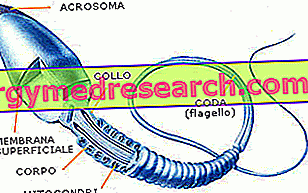Spermatozoa are human reproductive cells. Also known as gametes or male germ cells, they are produced by the testicle, inside the seminiferous tubules. In order for spermatogenesis (the testicular synthesis of new spermatozoa) to take place, it is essential that the temperature of the scrotum - the sac in which the testicles are housed - is 2-4 ° C lower than the body temperature. Be careful, therefore, to wear underwear or pants that are too tight, since the temperature rise could significantly reduce fertility.
The spermatozoa are emitted outside on the occasion of orgasm, ascending the following structures: epididymis, vas deferens, ejaculatory canal and urethra (unlike the feminine one, the urethra of man is common both to the excretory and to the genital). During this journey, the spermatozoa are mixed with the secretion of the accessory sperm glands (prostate, seminal glands and bulbourethral glands), which has the purpose of sterilizing the urethra, increasing sperm vitality, supplying them with food (mainly fructose) and guaranteeing them better lubrication and survival in the female genital tract. The spermatozoa and this whitish liquid, a little sticky, is called sperm. As anticipated, the sperm is expelled abruptly and fleets from the erect penis; this spill, called ejaculation, coincides with the culmination of pleasure and sexual excitement, that is, with orgasm. The average volume of the ejaculate is between 2 and 5 ml.
The complete maturation of a spermatozoon takes about 64 days; at all times, however, different regions of the seminiferous tubules contain spermatocytes (sperm precursors) at different stages of development. Thanks to this time lag, the production rate is almost constant and can be estimated at around 100-200 million spermatozoa per day.
Once produced, the spermatozoa come out of the seminiferous tubules and are conveyed to the epididymis, where - within the 12 days necessary to follow it - they complete their maturation, acquiring motility. They are then stored until ejaculation, during which a man emits on average 300 million spermatozoa. If these are not ejaculated, with the passage of time they degenerate and are reabsorbed by the vas deferens. For this reason, if you are looking for a child it is useless, and even counterproductive, to abstain from sexual intercourse believing that you increase the concentration of sperm available for fertilization. On the contrary, those aged will constitute a physical obstacle to younger and healthier spermatozoa; the abstention period should therefore not exceed 3-4 days.
Unlike women - who at birth have a well-defined set of potential egg cells - male spermatozoa begin to be produced only at puberty.

The extraordinary number and mobility of spermatozoa is an essential feature to guarantee fertilization. In fact, once poured into the vagina, the spermatozoa are faced with a series of obstacles, first of all the cervical mucus. Only the part of them that manages to escape the meshes of this viscous and reticular substances, will be able to proceed in the path towards the fallopian tubes. Thus, out of the 300 million spermatozoa poured into the vagina, only a few hundred will be able to reach the egg cell and, of these, only one will be able to fertilize it, if necessary. The entire journey does not take place randomly, but results chemically and mechanically driven (muscular contractions of the uterus, the tube and the cilia of the mucous membranes).
During the passage in the female genital tract, the spermatozoa acquire the ability to fertilize, through chemical-physical modifications that together take the name of capacitation. These transformations greatly increase mobility.
Upon reaching the egg cell, the spermatozoa face two barriers: a layer of cells called the radiate corona - easily overcome - and a much more difficult obstacle, represented by the zona pellucida (a glycoprotein coating that envelops the egg in its entirety). To overcome this last impediment to fertilization, the sacrifice of more sperms is necessary. These cute "tadpoles", as someone defines them, in fact present a vesicle, called acrosome, located - by hat - near the apex of the head. Inside there are enzymes capable of demolishing the zona pellucida; however, for this resistance to be definitively broken, the contribution of more sperm is needed. The glycoprotein barrier will then be progressively weakened, to the point of allowing one of them to complete his mission, which is precisely to create a small gap to unite his nucleus - containing the genetic makeup of his father - with that of the oocyte. This union, which gives birth to a new life, will have required the sacrifice of millions of spermatozoa.
The quality of the sperm, as well as the quantity, survival time, morphology and mobility of the spermatozoa, can be assessed by a simple examination called a spermogram. The results of the spermiogram can show a perfectly normal picture or a series of alterations that - for what was said during the article - compromise the male fertility up to the sterility. These include:
- azoospermia : total absence of spermatozoa
- oligospermia : sperm count less than 30 million / ml of sperm
- astenospermia : insufficient spermatozoa mobility
- oligo-asteno-spermia : association of low number, low mobility and short survival
- teratospermia : the number of abnormal spermatozoa is too high
- necrospermia : high percentage of motionless spermatozoa (dead)
- lack of fructose in the sperm
To maintain the health of its reproductive system, and of the spermatozoa it produces, it is very important that men follow a healthy diet, maintain a healthy weight, masturbate or have regular sexual intercourse, follow physical activity and avoid smoking, the alcohol and underwear too tight or antiperspirant; pollution can also adversely affect sperm count and mobility.



